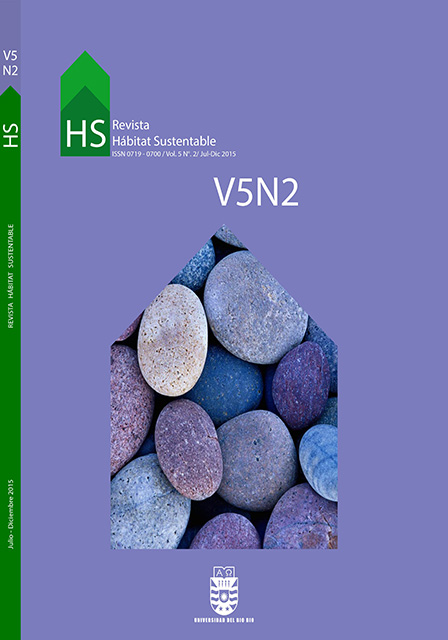Applicability of generic passive design strategies in buildings under the influence of Climate Change in Concepción y Santiago, Chile
Keywords:
Climate change, thermal comfort, adaptive comfort, passive design strategiesAbstract
Passive design strategies in architecture and building performance are normally quantified based on weather files that do not generally consider weather forecasts. This paper investigates the generation of future weather data and its influence on hygrothermal comfort, as well as the applicability of generic passive design strategies. To this end, climate scenarios were generated for Concepción and Santiago, two of the most highly populated conurbations in Chile, for the years 2020, 2050 and 2080. Predictions were produced for the most extensive greenhouse gas emissions scenario, GEIA 2 or “medium-high”, according to the Intergovernmental Panel on Climate Change (IPCC). Comfort levels were analysed using an adaptive approach and considering generic design strategies, both of which are included in ASHRAE standards. Upon analysing the weather forecasts with comfort models, results were obtained that provide a better understanding of the degree of adaption of both the users and the architecture to the possible future climate. This research creates generic strategies to optimize the design of buildings in Chile.
Downloads
References
AHSRAE STANDARDS COMMITTEE. Thermal Environmental Conditions for Human Occupancy: 2013. Atlanta, American Society of Heating, Refrigerating and Air-conditioning, 2013.
AHSRAE TECHNICAL COMMITTEE. ASHRAE Handbook of Fundamentals: 2005. Atlanta, American Society of Heating, Refrigerating and Air-conditioning, 2005.
BELCHER, Stephen, HACKER, Jacob y POWELL, Diana. Constructing design weather data for future climates. Building Services Engineering Research and Technology [En línea]. 2005, nº26, pp. 49-61. [Consultado 25 agosto 2015]. DOI: 10.1191/0143624405bt112oa
BOUDEN, Chiheb y GHRAB, Nadia. An adaptive thermal comfort model for the Tunisian context: A field study results. Energy and Buildings. [En línea]. 2005, nº37, pp. 952–963. [Consultado 25 agosto 2015]. DOI: 10.1016/j.enbuild.2004.12.003
ENERGY DESIGN TOOL UCLA. [en línea]. [Consultado 28 agosto 2015]. Disponible en: http://www.energydesign-tools.aud.ucla.edu/
ERIKSEN, Siri, ALDUNCE Paulina, SEKHAR, Chandra, D’ALMEIDA, Rafael, MOLEFE, John Isaac, NHEMACHEN, Charles, O’BRIEN , Karen, OLORUNFEMI, Felix, PARK, Jacob, SYGNA, Linda y ULSRUD, Kirsten. When not every response to climate change is a good one: Identifying principles for sustainable adaptation. Climate and Development [En línea]. 2011, nº3, pp. 7–20. [Consultado 25 agosto 2015]. DOI: 10.3763/cdev.2010.0060
FANGER, Povl Ole. Thermal Comfort.1ª ed. Copenhangen: Danish Technical Press, 1970.
FERIADI, Henry y WONG, Nyuk Hien. Thermal comfort for naturally ventilated houses in Indonesia. Energy and Buildings [En línea]. 2004, vol. 36, n°7, pp. 614–626. [Consultado 25 agosto 2015]. DOI: 10.1016/j.enbuild.2004.01.011
GUAN, Lisa. Preparation of future weather data to study the impact of climate change on buildings. Building and Environment [En línea]. 2009, nº44, pp. 793-800. [Consultado 25 agosto 2015]. DOI:10.1016/j.buildenv.2008.05.021
GIVONI, Baruch. Man, Climate and Architecture. 1ª ed. Amsterdam/London/New York: Elsevier Publishing Company Limited, 1969.
HUMPHREYS, Michael y NICOL, Fergus. Adaptive thermal comfort and sustainable thermal standards for buildings. Energy and Buildings [En línea]. 2002, vol. 34 nº6, pp. 563–572. [Consultado 25 agosto 2015]. DOI: 10.1016/S0378-7788(02)00006-3
INTERGOVERNMENTAL PANEL ON CLIMATE CHANGE. Climate Change 2014: Synthesis Report. Contribution of Working Groups I, II and III to the Fifth Assessment Report of the Intergovernmental Panel on Climate Change: 2014. Ginebra: IPCC, 2014.
JENTSCH, Mark F., BAHAJ, AbuBakr S. y JAMES, Patrick A. B. Climate change future proofing of buildings - Generation and assessment of building simulation weather file. Energy and Buildings [En línea]. 2008, nº40, pp. 2148–2168. [Consultado 25 agosto 2015]. DOI: 10.1016/j.enbuild.2008.06.005
MET OFFICE. Met office Hadley centre [en línea]. [Consultado 28 agosto 2015]. Disponible en: http://www.metoffice.gov.uk/climate-change/resources/hadley
MYLONA, Anastasia. The use of UKCP09 to produce weather files for building simulation. Building Services Engineering Research and Technology [En línea]. 2010, vol. 33, n°1, pp. 51-62. [Consultado 25 agosto 2015]. DOI: 10.1177/0143624411428951
OFICINA DE CAMBIO CLIMÁTICO. Plan Nacional de Adaptación al Cambio Climático: 2014. Santiago: Ministerio del Medio Ambiente, 2014.
ROBERT, Amélie, KUMMERT, Michaël. Designing net-zero energy buildings for the future climate, not for the past. Building and Environment [En línea]. 2012, nº55, pp. 150-158. [Consultado 25 agosto 2015]. DOI: 10.1016/j.buildenv.2011.12.014
SCHIERMEIER, Quirin. The real holes in climate science. Nature [En línea]. 2010, vol. 463, n°7279, pp. 284–287. [Consultado 25 agosto 2015]. DOI: 10.1038/463284a
UNIVERSITY OF SOUTHAMPTON. Sustainable Energy Research Group [en línea]. [Consultado 28 agosto 2015]. Disponible en: http://www.energy.soton.ac.uk/ccworldweathergen/
U.S. Department of Energy [en línea]. [Consultado 28 agosto 2015]. Disponible en: http://apps1.eere.energy.gov/buildings/energyplus/weatherdata_about.cfm
Downloads
Published
How to Cite
Issue
Section
License
The content of articles which are published in each edition of Habitat Sustentable, is the exclusive responsibility of the author(s) and does not necessarily represent the thinking or compromise the opinion of University of the Bio-Bio.
The author(s) conserve their copyright and guarantee to the journal, the right of first publication of their work. This will simultaneously be subject to the Creative Commons Recognition License CC BY-SA, which allows others to share-copy, transform or create new materials from this work for non-commercial purposes, as long as they recognize authorship and the first publication in this journal, and its new creations are under a license with the same terms.











 Scientific Information Program/Concurso Fondos de Publicación de Revistas Científicas 2018/ Proyecto Mejoramiento de Visibilidad de Revistas UBB (Código:FP180007).
Scientific Information Program/Concurso Fondos de Publicación de Revistas Científicas 2018/ Proyecto Mejoramiento de Visibilidad de Revistas UBB (Código:FP180007).





